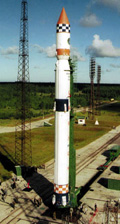|
|


Project Outline
CORONAS stands for "Complex Orbital Near-Earth Observations of the Solar Activity" (in Russian). The CORONAS Project, conducted under the auspices of ROSAVIAKOSMOS within the framework of the "basic space research" section of the Federal space research program, was designed with the provision for three consecutive launches of the similar spacecraft, the Orbiting Solar Observatory. Each orbiter should be equipped with a set of devices capable of obtaining data in the broadest possible range of electromagnetic radiation, varying from Gamma- and X-rays and up to the radio waves. The three stages of the Project where named CORONAS-I, CORONAS-F and PHOTON. The first of the three satellites, CORONAS-I, was successfully launched on March 2, 1994 from the Plesetsk launch area in the North of Russia by the CYCLONE-3 booster rocket. Unfortunately, due to an onboard problem the CORONAS-I satellite was fully operational (preserving precise orientation) during few months only. The second spacecraft, CORONAS-F, was launched on July 31, 2001. CORONAS satellites are placed into the polar orbits with an altitude of about 500 km and inclination about 83 degrees. The resulting quasi-synchronous orbit assures periods of recurrence of up to 20 days during which the satellite stays out of the Earth's shadow. The mission is aimed on the study of the two major problems of the Solar physics - the internal structure of the Sun and theory of solar flares. The two principal methods used to study the internal structure of the Sun are helioseismology and neutrino astronomy. The CORONAS satellites allow continuous helioseismological observations of the Sun over the periods of up to 20 days which is very important for this method. Short-term ground-based observations prevent high-frequency resolution in the observed spectrum of eigenmodes. Besides, the presence of atmosphere increases the level of noise and reduces sensitivity of ground-based observations. Among the principal scientific objectives of the project are
CORONAS is an international project with participants from Russia, Ukraine, Poland, Slovakia, Bulgaria, Germany, USA and France. The coordination of all activity within the framework of CORONAS project is carried out by IZMIRAN (Institute of Terrestrial Magnetism, Ionosphere and Radio Wave Propagation, Russian Academy of Sciences) |
Last modified: Sep 08 2004 10:49 MSD
Feedback and comments concerning this site please direct to CORONAS webmaster
Data access requests and telemetry processing issues direct to CORONAS Operator
